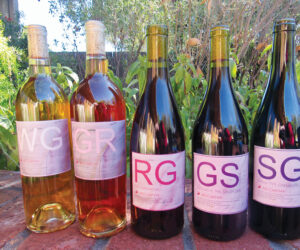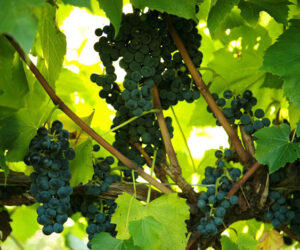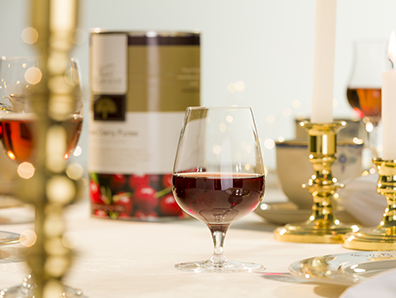
Dessert wine paired with a sweet pie, savory cheese, or fine cigar is one of the best ways to finish off an excellent meal. Home winemakers have a variety of dessert wine styles to choose from when venturing down this path, ranging from low-alcohol sweet options such as Muscat wines, to naturally enriched icewines to fortified Ports.
Port wines, which are traditionally produced in the Douro Valley in Portugal, are made by arresting the fermentation of juice through the addition of a high-alcohol fortifying agent to produce a final wine that has an alcohol content of approximately 20% and a residual sugar content of approximately 8%. (Note that when made outside of Portugal, these wines are referred to as “Port-style” wines.) While Ports are traditionally made from grapes, it is possible to use other fruit juices as the basis of this process, giving home winemakers a large palette of flavors to work with in the production of unique fortified dessert wines.
Planning Your Fruit Port-Style Wine
One of the first decisions that will need to be made when planning your fruit Port-style wine is how you will go about fortification. Traditionally, high alcohol content “neutral grape spirits,” which are made by repeated distillation of wine to reach an alcohol content of 190-proof (95% ethyl alcohol), are the best option for making Port-style wines from grape-based wines. However, when making Port-style wines from other fruits, using an even more neutral, high-alcohol spirit is a better option, and the easiest spirit in this category is 190-proof Everclear. Everclear is produced from grains and will add no flavor to your wine, only fortification of the alcohol level. Note that 190-proof Everclear is not legal in all US states, so check your local laws before using this option. While lower alcohol spirits can be used for fortification, you will need a larger volume, resulting in further diluting the fruit character of your final wine.
The Pearson Square is a critical part of planning your Port-style wine, and is used to determine the initial formulation of the pre-fermentation juice, when to stop fermentation, the volumes of wine and fortifying agent to use, and the final volume of the finished wine.
Let’s assume that the goal is to make 6 gallons (22.7 L) of a Port that has a 20% alcohol content, the initial wine has a 10% alcohol content, and 190-proof (95% alcohol) Everclear will be used as the fortifying agent. The Pearson Square can then be used to determine the blend ratios needed to make the desired final product, which are calculated as follows:
(A) represents the alcohol content of the initial wine(B) represents the alcohol content of the fortifying liquor
(C) represents the target alcohol content of the finished wine
(D) represents the parts of initial wine to be used in the Port (and is calculated as D = B – C)
(E) represents the parts of Everclear in the blended wine (and is calculated as E = C – A).
So for our example, which you can see above laid out in a grid, looks like this:
(A) 10%
(B) 95%
(C) 20%
(D) 95-20 = 75
(E) 20-10 = 10
The total parts in the Port-style wine is D + E, which can then be used to calculate the relative volumes of the initial wine and Everclear to be used. In this case, the total parts in the Port-style wine is 85, with 75 parts (88%) being the initial fruit wine and 10 parts (12%) being the 190-
proof Everclear. So, if the goal is to make 6 gallons (22.7 L) of Port-style wine, then 12% of this volume (2.9 quarts/2.7 L) needs to be 190-proof Everclear and 88% of the volume (21.1 quarts/20 L) will be made up from the initial wine. Since the Everclear will add no sugar to the final wine, the initial wine needs to have a sugar content of about 10% to deliver the desired 8% sugar to the final product using this same dilution scheme.
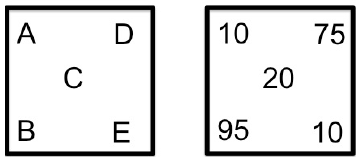
Pearson Square analysis of the planning for a fruit Port
One of the advantages of non-grape fruit wines is that it is relatively easy to produce a wine with a desired alcohol and sugar content simply by modifying the sugar content of the initial juice. In order to produce a wine with 10% sugar and 10% alcohol, all that is needed is to adjust the initial sugar content of the juice to a specific gravity of 1.100, which has an alcohol potential of 15% and a 26% sugar content. Fermentation of this juice to a specific gravity of 1.040 will result in a wine that has an alcohol content of 10% and a sugar content of around 10%. Preparing a juice that has a specific gravity of 1.100 from fruit purees requires six 49-oz. (1.45 L) cans of puree and between 12–14 lbs. (5.4–6.4 kg) of sugar diluted with clean, chlorine-free water to a total volume of about 6 gallons (22.7 L). Note that fruit purees will have an inherent sugar content that will continue to the overall sugar content of the initial juice. Actual sugar content depends on the type of fruit puree used, and manufacturers will typically provide sugar contents expressed in degrees Brix on product labels.
If you want to get the formulation just right the first time, it is best to start with only 10 lbs. (4.5 kg) of sugar added to the juice followed by measuring the specific gravity of the juice and then adding more sugar as needed. Do not worry if the initial juice has a specific gravity other than 1.100; you can simply change the target final specific gravity from fermentation to accommodate, although the sugar content of the final wine will
be impacted.
Fermenting, Fortifying, & Finishing Your Fruit Ports
Once the initial juice has been prepared, the next step is fermentation. Vintner’s Harvest VR21 is a fairly reliable yeast for non-grape fruit juice fermentation, but there is no reason not to use your favorite wine yeast here. Since effectively controlling the end point of fermentation is critical to produce a finished Port-style with the desired sweetness and alcohol content, fermentation should be monitored at least twice a day to ensure that the process is stopped at the desired final specific gravity.
Once that point is reached, the fermenting juice needs to be transferred into a 6-gallon (22.7-L) carboy containing 2.9 quarts (2.7 L) of 190-proof Everclear, which will produce a fortified wine with the desired alcohol and sweetness characteristics (based on our Pearson Square calculations done earlier). Adjustments in fermentation time can be made based on the actual specific gravity of your initial juice or if different alcohol or residual sugar levels are desired in the final product.
Once the wine has been transferred into your carboy and has been fortified, it is time to stabilize and clarify the product. First, degas the wine by vigorously stirring the wine 2–3 times per day over a three-day period. Once that has been accomplished, add 1 teaspoon each of potassium metabisulfite and potassium sorbate and stir the wine to ensure complete dissolution. After that, the wine can be clarified either by allowing it to stand for an extended time or through the use of a fining agent such as isinglass or DualFine. When using a fining agent, the wine should be clarified within 3–6 weeks.
While the wine is being clarified, it will need to be racked 1–3 times to remove the fines and lees; afterwards, the wine can be bottled. Be sure to top up the container with a compatible finished wine each time you rack if headspace is left in the receiving carboy. Another option is to add some sanitized glass marbles to fill the space and limit the air in the carboy.
Bottling, Aging, & Enjoying Your Fruit Port Wines
Once your Port-style wine has been clarified, it is ready to bottle. Traditionally, Ports are bottled in 375 mL bottles. Like everything that comes with home winemaking, these bottles aren’t a requirement, but they will add a nice variety to any cellar collection (and make it easier for a couple of people to finish a bottle in an evening so you don’t have half-open bottles left in the fridge). These wines can be bottled in any color of glass, and while clear glass nicely shows off the color of the wine, make sure exposure to light is limited to ensure that the color is preserved as the wine ages if you go this route.
Port-style wines made using this approach should be aged at least six months in the bottle, although they can be aged longer if desired. Pairing fruit Port-style wines with desserts gives a wide array of options to work with, allowing the balance or contrast not only of the sweetness but also of the robust fruit character of the wine. Fruit Port-style wines pair extremely well with desserts prepared from the same or complementary fruits such as pies, tarts, or cobblers. Similarly, these Port-styles pair nicely with a plate of dark chocolate and dried fruits, which can be either the same fruit used to make the wine or any complementary fruit.
Another option to consider would be to serve these wines with a contrasting savory dessert. Cheeses and cheese-based desserts are a great option, and the bright Port-styles made by this process, especially when served young, pair excellently with robust cheeses such as a sharp English cheddar or tangy blue cheese. Baked soft cheeses such as brie topped with dried fruit or a cheese-based pastry are also excellent pairing choices.
I have found that exploring pairings of unique fruit Port-style wines is one of the most exciting parts of the journey!
Cherry Port-Style Wine Recipe
Here is a recipe and step-by-step instructions for the production of a batch of cherry Port-style wine, based on the example given in the story:
Ingredients
Six 49-oz. (1.45-L) cans of sweet cherry puree
10 pounds (4.5 kg) of sugar (possibly more)
2.9 qts. (2.7 L) 190-proof Everclear
3 tsp. pectic enzyme
3 tsp. yeast nutrient
6 tsp. acid blend
1 tsp. grape tannin
1 tsp. potassium sorbate
1 tsp. potassium metabisulfite
1.5 oz. (43 g) isinglass
Water
Vintner’s Harvest VR21 yeast
Step by step
1. Clean and sanitize your primary fermenter.
2. Add 10 pounds (4.5 kg) of sugar and dissolve the sugar in ~2 gallons (8 L) of water.
3. Add three teaspoons each of pectic enzyme and yeast nutrient, six teaspoons of acid blend, and one teaspoon of grape tannin.
4. Add six 49-oz. (1.45-L) cans of sweet cherry puree.
5. Fill fermenter with water to a total volume of 6 gallons (22.7 L).
6. Stir juice thoroughly to dissolve and mix all ingredients.
7. Check initial specific gravity of the wine. If it is not at least 1.100, add sugar needed to bring up the SG to 1.100.
8. Sprinkle one 8-g packet of Vintner’s Harvest VR21 yeast on top of the juice.
9. During primary fermentation, stir the fermenting juice at least once a day to punch the cap and measure the specific gravity at least twice a day to keep close track of the fermentation process.
10. Once the specific gravity of the juice reaches 1.040, transfer the free run of the juice into a cleaned and sanitized 6-gallon (23-L) glass carboy containing 2.9 qts. (2.7 L) 190-proof Everclear. This can be accomplished by either using a fermentation vessel with a port at the bottom of the fermenter (such as FastFerment or Tuff-Tank fermenters) or by siphoning from below the cap.
11. Over the next three days, stir the wine thoroughly multiple times a day to degas as much as possible.
12. Add one teaspoon of potassium sorbate and one teaspoon of potassium metabisulfite and stir wine to dissolve. Note that fermentation will typically not stop completely for at least 12 hours, so make sure that the carboy is fitted with a fermentation lock to prevent a buildup of gas pressure inside the carboy.
13. After wine has been degassed and stabilized, add 1.5 oz. (43 g) isinglass and stir thoroughly.
14. Allow wine to stand until clear, and then rack away from the lees as many times as needed.
15. Depending on the volume of lees, it may be necessary to transfer the wine to a 5-gallon (19-L) carboy to limit oxygen exposure during clarification (or add sanitized glass marbles or a compatible, stable finished wine to the carboy to reduce the headspace).
16. Once the wine has been clarified, bottle as usual or in 375-mL bottles if preferred.
17. Allow the wine to sit in the bottle six or more months.
Limoncello
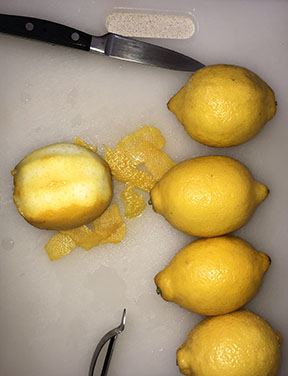
When I finished making my most recent batch of fruit Port-style wine, I realized that I had the better part of a half-gallon (2-L) of 190-proof Everclear remaining. I am way too old to make up a batch of jungle juice and call some friends over for a wild night, but I also didn’t want to waste leftovers. Luckily, when I was buying this batch of Everclear, the cashier told me about a friend of hers that makes limoncello from Everclear, which I thought was a great idea. It turns out that limoncello is actually a relatively simple thing to make at home and there are plenty of recipes you can find online. Basically, the process involves cleaning and carefully peeling lemons to ensure that only the peel (and not the pith) is collected. When cleaning lemons to be used in this process, I recommend using a product specifically designed to remove the wax coating often present on the lemon rinds.
The peels are then soaked in Everclear, which extracts oils, flavor compounds, and pigments from the peels. Infused alcohol is then filtered to remove any peel remnants and combined with a simple syrup to produce the limoncello. Ultimately, this recipe boils down to only four ingredients: Everclear, lemon peels, sugar, and water. As with any recipe, these four components can be easily balanced for personal taste, and based on the recipes I reviewed, I developed a simple starting point:
• Leftover 190-proof Everclear
• Peels from 1 large lemon for every 100 mL of Everclear
• 150 mL of water for every 100 mL of Everclear
• 1⁄3 cup of sugar for every 100 mL of Everclear
After my last batch of Port-style wine, I had 1.3 qts. (1.2 L) of Everclear left over, so I added the peels of 12 lemons to the Everclear in the bottle, and allowed the peels to infuse for two weeks. After the infused Everclear was filtered, it was combined with a simple syrup prepared from 4 cups of sugar dissolved in 1.9 qts. (1.8 L) of boiling water to produce approximately 1 gallon (4 L) of limoncello, which was then bottled in 375-mL bottles left over from my Port-style wine production. Here are the specific steps I used in the process:
Step by step
1. Thoroughly clean and dry 12 large lemons.
2. Peel lemons with a vegetable peeler, removing any remaining pith with a paring knife.
3. Add peels to the bottle of leftover 1.3 qts. (1.2 L) Everclear.
4. Tightly seal bottle and allow to stand for two weeks, shaking it periodically. During this time, the liquid level in my bottle was observed to decrease and it took on an increasingly dark yellow color.
5. Filter infused Everclear into a cleaned and sanitized 1-gallon (4-L) glass jug through a sanitized, non-bleached coffee filter. This resulted in a dark yellow liquid with a strong lemon scent.
6. Prepare simple syrup by dissolving four cups of sugar in 1.9 qts. (1.8 L) of boiling, filtered water. After the sugar is fully dissolved, allow the solution to cool.
7. Once cool, add the syrup to the infused Everclear, which will produce a cloudy, light yellow liquid.
8. Using a sanitized spoon, give the limoncello a good stirring and then bottle in sanitized 375-mL glass bottles.



